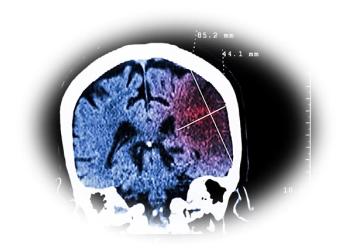
Supraventricular Tachycardia with Aberrancy
[Scroll down for Answers and Discussion]
HISTORY: A 50-year-old female with a history of hypertension and diabetes mellitus is brought to the ED by ambulance for sudden onset of palpitations and near-syncope. She denies any chest pain, shortness of breath, or history of heart disease. Her symptoms are ongoing at the time of your evaluation. She denies ever having felt like this before
EXAM: On exam she is in moderate distress stating she feels like she is going to pass out. Her pulse is rapid and weak at 210 beats/min and her blood pressure is 75/35 mmHg. Her lungs are clear and there is no peripheral edema. The rest of her exam including an oral temperature and pulse ox reading are unremarkable.
TESTS: A tracing showing three leads from her ECG is shown in Figure 1 above (please click to enlarge). Results of labs and chest x-ray are pending.
Initial Concern(s): supraventricular tachycardia (SVT), ventricular tachycardia (v-tach), Wolff-Parkinson-White (WPW) syndrome.
Questions
1. Is this SVT, V-tach, WPW or something else?
2. How should you treat this patient?
Answers
1. This is SVT with aberrancy.
2. The patient was treated with synchronized cardioversion.
Because the patient was clinically unstable with a pulse much faster than 150 beats/min (it was ~210) and a slightly wide QRS complex of ~166ms the decision was made to perform synchronized cardioversion. A modified Valsalva maneuver was tried first without effect. The defibrillator was prepared and a sedative was ordered but just prior to the sedative the patient spontaneously converted to normal sinus rhythm and the BP normalized. The EKG was faxed to a cardiologist who felt this was clearly SVT and cleared the patient for discharge home with outpatient follow-up.
Discussion
Supraventricular tachycardia (SVT) usually presents with the sudden onset (paroxysmal) of a rapid heart rate between 125-210 beats/min (rates can reach up to 250). The EKG typically shows regular, narrow QRS complexes. Symptoms may include palpitations, generalized weakness, SOB, and near syncope or syncope. Most cases of SVT are idiopathic, but some are secondary to cardiac conditions or drug toxicity (see page shot in Figure 2 above.)
Management of SVT should include establishing an IV and sending labs for magnesium and electrolyte levels while the patient is placed on a monitor and a stat EKG is done. Treatment recommendations for SVT have changed recently. Initial treatment should start with the modified Valsalva maneuver, which is more than twice as effective as the traditional Valsalva (see page shot in Figure 2 above). If that is ineffective, diltiazem is currently favored over adenosine for multiple reasons: it is more effective, safer, cheaper, easier to administer, and better tolerated by patients (see page shot in Figure 2 above). If medications are not effective or the patient is deemed to be unstable, cardioversion should be performed. Prevention of recurrence usually is with beta- or calcium-channel blockade or ablation performed by an electrophysiologist.
For additional information on diagnosis and treatment of tachycardia, please see
Newsletter
Enhance your clinical practice with the Patient Care newsletter, offering the latest evidence-based guidelines, diagnostic insights, and treatment strategies for primary care physicians.





















































































































































































































































































